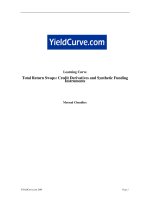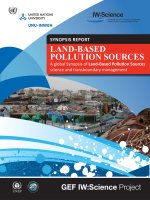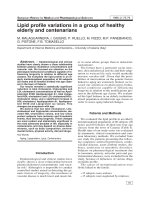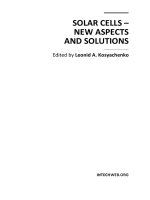Long-term global temperature variations under total solar irradiance, cosmic rays, and volcanic activity
Bạn đang xem bản rút gọn của tài liệu. Xem và tải ngay bản đầy đủ của tài liệu tại đây (736.9 KB, 4 trang )
Journal of Advanced Research 8 (2017) 329–332
Contents lists available at ScienceDirect
Journal of Advanced Research
journal homepage: www.elsevier.com/locate/jare
Short Communication
Long-term global temperature variations under total solar irradiance,
cosmic rays, and volcanic activity
Lilia Biktash
Department of Solar-Terrestrial Physics, IZMIRAN, Moscow, Troitsk, Russia
g r a p h i c a l a b s t r a c t
a r t i c l e
i n f o
Article history:
Received 30 October 2016
Revised 26 February 2017
Accepted 6 March 2017
Available online 14 March 2017
Keywords:
Global temperature
Total solar irradiance
Cosmic rays
Volcanic activity
a b s t r a c t
The effects of total solar irradiance (TSI) and volcanic activity on long-term global temperature variations
during solar cycles 19–23 were studied. It was shown that a large proportion of climate variations can be
explained by the mechanism of action of TSI and cosmic rays (CRs) on the state of the lower atmosphere
and other meteorological parameters. The role of volcanic signals in the 11-year variations of the Earth’s
climate can be expressed as several years of global temperature drop. Conversely, it was shown that the
effects of solar, geophysical, and human activity on climate change interact. It was concluded that more
detailed investigations of these very complicated relationships are required, in order to be able to understand issues that affect ecosystems on a global scale.
Ó 2017 Production and hosting by Elsevier B.V. on behalf of Cairo University. This is an open access article
under the CC BY-NC-ND license ( />
Introduction
Numerous investigations carried out recently report apparent
climate responses to the 11-year solar cycle, although the Sun’s
role for weather and climate remain a matter of controversy.
Long-term global temperature variations can be exposed to different cosmophysical and geophysical factors. It has been suggested
that the recent trend of global warming is mainly due to uncon-
Peer review under responsibility of Cairo University.
E-mail address:
trolled industrial activity. This trend is leading to irreversible
changes in the atmosphere, hydrosphere and biosphere. The consequences of this process are also observed in seismic and volcanic
activity. As hypothesized by Eddy [1], the climate variations might
be due to the total solar irradiance. Total solar irradiance (TSI) is a
measure of the solar energy flux. TSI describes the total radiant
energy, in the form of electromagnetic radiation emitted by the
Sun at all wavelengths, that falls for each second on 1 square meter
outside the Earth’s atmosphere, a value proportional to the ‘‘solar
constant” introduced earlier in the previous century. Lean and
Fröhlich [2] show that the radiative flux decreases when dark
/>2090-1232/Ó 2017 Production and hosting by Elsevier B.V. on behalf of Cairo University.
This is an open access article under the CC BY-NC-ND license ( />
330
L. Biktash / Journal of Advanced Research 8 (2017) 329–332
sunspots are present on the disk, and increases due to bright
faculae or plages. Fligge and Solanki [3], using a model of the total
solar irradiance since 1700, found that long-term TSI variations
exist due to the evolution of the solar network and other processes.
However, these variations are not significant enough to explain climate change, especially on a scale as large as that of global warming. Since the discovery of galactic and solar cosmic rays, their
influence on the Earth’s climate has been subject to speculation,
and now, cosmic ray activity as a possible mechanism affecting climate change is the subject of considerable debate. Cosmic rays
(CRs) are high energy charged particles, originating in outer space,
that travel at nearly the speed of light and strike the Earth from all
directions. Cosmic rays can be divided into two types: galactic cosmic rays (GCRs) and solar energetic particles (SEPs). GCRs are high
energy particles originating outside the solar system, whereas SEPs
are high energy particles (predominantly protons) emitted by the
Sun, primarily in solar particle events. However, the term ‘‘cosmic
ray” is often used to refer only to the GCR flux. Recent studies by
Pudovkin and Raspopov [4], Tinsley [5], and Swensmark [6], have
shown that the Earth’s cloud coverage is strongly influenced by
cosmic ray intensity. Conditions in interplanetary space, which
can influence GCRs and climate change, have been studied in
numerous works. As has been demonstrated by Biktash [7], the
long-term CR count rate and global temperature variations in
20–23 solar cycles are modulated by solar activity and by the
IMF (interplanetary magnetic field). A possible geophysical factor
which is able to affect the influence of solar activity on the Earth’s
climate is volcanism. The effects of volcanism can lead to serious
consequences in the atmosphere and the climate, as shown by
Robock [8]. A study of solar activity influence on global air–surface
temperature with and without volcanic impact is presented by
Barlyaeva et al. [9]. The main findings and mechanisms have implications for the question of where and how the Sun exerts influence
on the climate system.
The purpose of this work is to find out whether there are decadal variations in the Earth’s climate, try to establish their spatial
and temporal distribution, and how this distribution comes about.
The findings will then be used in the important task of finding a
possible explanation for the contradictory results presented in literature studies of the impact of solar activity on the Earth’s climate. Volcanic signals in the 11-year variations of the Earth’s
climate are discussed, with a final proposal suggesting that solar,
human and volcanic activity extert a combined effect on the Earth’s
climate.
Data and method
The sunspot numbers (SSN), global surface air temperatures
(GSAT), TSI, interplanetary magnetic field (IMF), cosmic rays
annual means data during solar cycles 19–23 are used for studying
long-term air temperature variations. The IMF and SSN data were
obtained from the OMNI database />TSI data are used from CR data were
taken from the Climax () neutron monitor
and annual means of air temperature were obtained from
The air temperature trend is
analyzed by the least square fit to the linear relation y = bx + a,
where y is GSAT, x is years of trend study.
Results and discussion
Camp and Tung [10] obtained a global warming signal attributable to the 11-year TSI cycle. It was found that there was a globally averaged warming of objectively almost 0.2 K during solar max
as compared to solar min. More importantly, they established that
the global-temperature response to the solar cycle is statistically
significant at over 95% confidence level. The spatial pattern of the
warming is of interest, as it shows the polar amplification also
expected for the greenhouse effect. The statistical significance of
such a globally coherent solar response at the surface was established first time by Camp and Tung [10]. The result of this paper
is open to debate, as several interpretations can be suggested from
the graphs and conclusions. It should also be noted that the current
finding contradicts our previous results [7]. Camp and Tung [10]
show the detrended temperature variations in K and show ±0.2 K
during solar max and solar min, whereas our calculation of
detrended GSAT demonstrates ±0.1 °C variations. It is important
to carry out a secondary analysis to compare results presented
before [7,10]. The detrended annual means of GSAT variations
(denoted as GT) throughout of solar cycles was calculated by the
expression GT = 0.016X À 0.11 [7] with the high correlation
(R = 0.86) for the trend removal. It was shown that the GT variations are very small and their running average changes from
+0.1 °C to À0.1 °C during solar cycle 20–23. For these solar cycles,
our calculations of SSN, CRs and IMF B (B is module of interplanetary magnetic field) trends do not show a significant effect, whilst
the GSAT trend is very large, and significant. Fig. 1 shows the
annual variations of SSN (Panel a), GSAT (dashed line in Panel b)
and its trend. It should be noted that GSAT does not have a trend
during solar cycle 19, and varies according the solar cycle.
Detrended GSAT (thick curve in Fig. 1) and its running average
variations (solid curve) changes from +0.1 °C to À0.1 °C and is
reduced by about 50% compared to Camp and Tung’s results [10].
Thus, the relationship of SSN and GT supports the argument
that climate variations might be due to the TSI. The change in
the amount of solar energy entering the lower atmosphere should
lead to a change in the temperature of the atmosphere. However,
there is a large gap between the energy of atmospheric processes
and the TSI changes. It is now generally accepted that centennial
modulation of 11 year TSI driving alone is too small to explain global warming. TSI measurements differ widely in experiments, and
show unusual behaviour of ultraviolet irradiance during solar
cycles. For these reasons, the Sun’s role in observed global warming
has remained a matter of controversy. The disparity of the findings
and the lack of established physical mechanisms that could
amplify energetically weak TSI variations results in a confusing
state of affairs.
Let us consider, one after another, the effects of TSI, CRs, and
volcanic activity in the course of development of solar activity
cycles for a clear explanation of the effect on detrended GSAT.
Fig. 2 shows GT (Panel a, dashed curve), and its running average
variations (Panel a, solid curve). Annual means of the IMF B and
TSI are presented in Panel b; CR variations are presented in Panel
c (CLIMAX measurements). It is clearly evident that GT varies
accordingly to TSI and opposite to CRs. It is apparent that the rising
of GT during solar maxima is a result of these processes. The physical mechanism of the influence of TSI on GT variations can be represented from Fig. 2 as follows. As has been pointed out and cited
above, the Earth’s atmosphere varies in transparency with the level
of solar activity under modulated streams of CRs. In these conditions the cloud cover in the atmosphere is decreased during solar
maxima and increased during solar minima. TSI energy entering
to the Earth’s atmosphere owing to CR variations has a different
effect on GT, even though TSI is small variated or constant. Thus,
having established the existence of a solar cycle effect on the main
part of climate variations, unequal energy input of TSI to the lower
atmosphere can be explained as a result of cloud cover variation
during a solar cycle under the variation of the intensity of the cosmic ray fluxes. Therefore, enhanced cloud cover in solar min acts as
gray filter which blocks part of TSI falling on the Earth’s surface and
GT is reduced.
L. Biktash / Journal of Advanced Research 8 (2017) 329–332
331
Fig. 1. The annual variations of SSN (Panel a), GSAT (dashed line in Panel b), detrended GSAT (denoted as GT) and its running average variations (the solid curve in Panel b).
Fig. 2. Detrended GSAT denoted as GT – Panel a – the dashed curve, and its running average variations – the solid curve in Panel a; annual means of IMF B and TSI in Panel b;
CR CLIMAX variations in Panel c.
There are 1–2 years of global temperature depressions about
0.1 °C as shown in Fig. 2. A possible factor that could explain these
temperature depressions is volcanism. The effect of volcanism on
climate can be very strong, and can lead to serious consequences
in the atmosphere and the climate, as shown by Robock [8]. One
can see that the dates of the largest volcanic activity are associated
with the descending phases of the solar cycles, as was noted by
Barlyaeva [11]. Large volcanic events are shown in Fig. 2 by trian-
gles: 1 – Fuego, 2 – El Chichon, 3 – Pinatubo, 4 – Ulawun, 5 –
Manam. These events can be seen in many studies where volcanic
activity is presented [9,11]. The main trigger mechanism of volcanic activity can be recurrent magnetic activity. Long-lasting,
recurrent magnetic storms are produced by the joint action of
the interplanetary magnetic field and solar wind velocity. They
can exert primary control over processes in the terrestrial core
and give rise to seismic or volcanic activity. This subject is under
332
L. Biktash / Journal of Advanced Research 8 (2017) 329–332
discussion in the Journal for New Concepts in Global Tectonics.
Fig. 2 shows that the IMF B maxima are shifted to TSI maxima
and are close to the declining phases of SC. Therefore, several years
of global temperature drop can firstly be attributed to TSI variations, and then to volcanic signals that are also can be related to
geomagnetic activity. In this case, global temperature is increased
as result of an increase in the atmosphere’s transparency and acts
in opposition to volcanic activity. Thus, there are combined effects
of solar, CRs, volcanic and human activity on climate change.
Conclusions
The results presented above permit the following conclusions: a
large proportion of climate variations can be explained by the
action of TSI and CR action on the state of the lower atmosphere
and meteorological parameters. The trends of SSN, CRs, and IMF
B for 20–23 solar cycles do not show a significant effect, whilst
the GSAT trend is very large, and significant. This is a forcible argument to attribute GSAT trend to human activity. The role of volcanic signals in the 11-year variations of the Earth’s climate can
expressed as several years of global temperature drop. This suggests that there are combined effects of solar, cosmic rays, geophysical and human activity on climate change patterns. It
should be noted that more detailed investigations of such complex
interactions are necessary.
Conflict of interest
The authors have declared no conflict of interest.
Compliance with Ethics Requirements
This article does not contain any studies with human or animal
subjects.
Acknowledgments
The author is very thankful to the referee for useful remarks and
the careful analysis of my paper.
References
[1] Eddy JA. The maunder minimum. Science 1976;192:1189–202.
[2] Lean J, Fröhlich C. Solar total irradiance variations. In: Blasubramaniam K,
Harvey J, Rabin D, editors. Synoptic solar physics. ASP Conference Series, vol.
140. p. 281–92.
[3] Fligge M, Solanki SK. The solar spectral irradiance since 1700. Geophys Res Lett
2000;27(14):2157–60.
[4] Pudovkin MI, Raspopov OM. The mechanism of action of solar activity on the
state of the lower atmosphere and meteorological parameters (a review).
Geomagn Aeron 1992;32:593–608.
[5] Tinsley BA. Influence of solar wind on the global electric circuit, and inferred
effects on cloud microphysics, temperature, and dynamics in the troposphere.
Space Sci Rev 2000;94:231–58.
[6] Swensmark H. Cosmic rays and Earth’s climate. Space Sci Rev 2000;93:175–85.
[7] Biktash LZ. Evolution of Dst index, cosmic rays and global temperature during
solar cycles 20–23. Adv Space Res 2014;54:2525–31.
[8] Robock A. Volcanic eruptions and climate. Rev Geophys 2000;38:191–219.
[9] Barlyaeva TV, Mironova IA, Ponyavin DI. Nature of decade variations in the
climatic data of the second half of the 20th century. Doklady Earth Sci
2009;425A:419–23.
[10] Camp ChD, Tung KK. Surface warming by the solar cycle as revealed by the
composite mean difference projection. Geophys Res Lett 2007;34:L14703.
[11] Barlyaeva TV. External forcing on air-surface temperature: geographical
distribution of sensitive climate zones. J Atmos Solar Terr Phys
2013;94:81–92.









